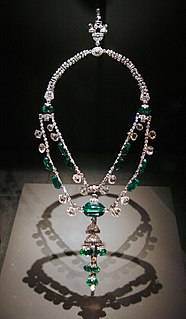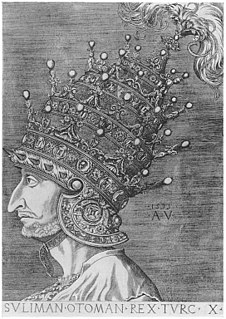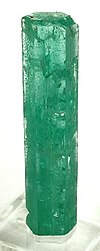
The Hope Diamond is a 45.52-carat (9.104 g) diamond originally extracted in the 17th century from the Kollur Mine in Guntur, India. It is blue in color due to trace amounts of boron. Its exceptional size has revealed new information about the formation of diamonds.

Crown jewels are the objects of metalwork and jewellery in the regalia of a current or former monarchy. They are often used for the coronation of a monarch and a few other ceremonial occasions. A monarch may often be shown wearing them in portraits, as they symbolize the power and continuity of the monarchy. Additions to them may be made, but since medieval times the existing items are typically passed down unchanged as they symbolize the continuity of the monarchy.

The Cullinan Diamond is the largest gem-quality rough diamond ever found, weighing 3,106.75 carats (621.35 g), discovered at the Premier No.2 mine in Cullinan, South Africa, on 26 January 1905. It was named after Thomas Cullinan, the mine's chairman. In April 1905, it was put on sale in London, but despite considerable interest, it was still unsold after two years. In 1907, the Transvaal Colony government bought the Cullinan and Prime Minister Louis Botha presented it to Edward VII, King of the United Kingdom, who had it cut by Joseph Asscher & Co. in Amsterdam.

The French Crown Jewels comprise the crowns, orb, sceptres, diadems and jewels that were symbols of Royal power between 752 and 1825. These were worn by many Kings and Queens of France. The set was finally broken up, with most of it sold off in 1885 by the Third Republic. The surviving French Crown Jewels, principally a set of historic crowns, diadems and parures, are mainly on display in the Galerie d'Apollon of the Louvre, France's premier museum and former royal palace, together with the Regent Diamond, the Sancy Diamond and the 105-carat (21.0 g) Côte-de-Bretagne red spinel, carved into the form of a dragon. In addition, some gemstones and jewels are on display in the Treasury vault of the Mineralogy gallery in the National Museum of Natural History.

The Iranian National Jewels, originally the Iranian Crown Jewels, include elaborate crowns, thirty tiaras, and numerous aigrettes, a dozen bejeweled swords and shields, a number of unset precious gems, numerous plates and other dining services cast in precious metals and encrusted with gems, and several other more unusual items collected or worn by the Persian monarchs from the 16th century and on. The collection is housed at the Treasury of National Jewels, situated inside the Central Bank of Iran on Tehran's Ferdowsi Avenue.

Harry Winston was an American jeweler. He donated the Hope Diamond to the Smithsonian Institution in 1958 after owning it for a decade. He also traded the Portuguese Diamond to the Smithsonian in 1963 in exchange for 3,800 carats of small diamonds.

The Star of Bombay is a 182-carat (36.4-g) cabochon-cut star sapphire originating from Sri Lanka. The violet-blue gem was given to silent film actress Mary Pickford by her husband, Douglas Fairbanks. She bequeathed it to the Smithsonian Institution. It is the namesake of the popular alcoholic beverage Bombay Sapphire, a British-manufactured gin.

The monarch of the Commonwealth realms, Queen Elizabeth II, owns a historic collection of jewels – some as monarch and others as a private individual. They are separate from the Gems and Jewels and the coronation and state regalia that make up the Crown Jewels.

The Spanish Inquisition Necklace is a diamond and emerald-studded necklace. As of 2008, it is on display at the Smithsonian Institution in Washington, D.C., United States. It was given its name by Harry Winston, the American jeweller who acquired it from the Maharaja of Indore, and has no known connection with the historical Spanish Inquisition.

The Nassak Diamond is a large, 43.38 carats (8.676 g) diamond that originated as a larger 89 carat diamond in the 15th century in India. Found in Golconda mines of Kollur and originally cut in India, the diamond was the adornment in the Trimbakeshwar Shiva Temple, near Nashik, in the state of Maharashtra, India from at least 1500 to 1817. The British East India Company captured the diamond through the Third Anglo-Maratha War and sold it to British jewellers Rundell and Bridge in 1818. Rundell and Bridge recut the diamond in 1818, after which it made its way into the handle of the 1st Marquess of Westminster's dress sword.
Graff is a British multinational jeweller based in London. It was founded by British jeweller Laurence Graff in 1960. A vertically integrated company, Graff operations comprise the design, manufacture and retail distribution of jewellery and watches.

The Bismarck Sapphire Necklace is a sapphire necklace designed by Cartier, Inc. in 1935. As of 2010, the necklace is on display between the Hall Sapphire and Diamond Necklace and the Logan Sapphire in the Janet Annenberg Hooker Hall of Geology, Gems, and Minerals at the Smithsonian Institution's National Museum of Natural History in Washington D.C., United States. It is named after Countess Mona von Bismarck, who donated the piece to the Smithsonian in 1967. The sapphire itself was mined in Burma, and was purchased by the Countess in Sri Lanka in 1926 during her honeymoon with Harrison Williams.
The Dom Pedro aquamarine is the world's largest cut aquamarine gem. It was cut from a crystal originally weighing approximately 100 pounds (45 kg) and measuring more than 3 feet (0.91 m) in length. The stone was mined in Pedra Azul, in the state of Minas Gerais in Brazil around 1980, and named after the Brazilian emperors Pedro I and Pedro II. The blue-green gemstone was cut by Bernd Munsteiner into an obelisk form weighing 10,363 carats. The finished dimensions measure 14 inches (36 cm) tall by 4 inches (10 cm) wide. The jewel was donated to the Smithsonian Institution by Jane Mitchell and Jeffery Bland. It is housed in the National Museum of Natural History's Janet Annenberg Hooker Hall of Geology.
Cindy Chao is a Taiwanese jewellery designer. She founded her company, Cindy Chao The Art Jewel, in 2004. She is known for her Black Label Masterpiece Collection and Annual Butterfly.

Emeralds are green precious gemstones that are mined in various geological settings. They are minerals in the beryl group of silicates. For more than 4,000 years, emeralds have been among the most valuable of all jewels. Colombia, located in northern South America, is the country that mines and produces the most emeralds for the global market, as well as the most desirable. It is estimated that Colombia accounts for 70–90% of the world's emerald market. While commercial grade emeralds are quite plentiful, fine and extra fine quality emeralds are extremely rare. Colombian emeralds over 50 carat can cost much more than diamonds of the same size.
Janet Annenberg Hooker (1904–1997) was an American philanthropist.

The "Star of the East" is a 94.78-carat, pear-shaped, D-color stone of VS2 clarity grade. Its exact origin is unknown, but it likely originated from India. The origin of its name and year of discovery are also unknown. The diamond was part of the collection of the jewelry-loving Sultan of the Ottoman Empire, Abdul Hamid II. It later made it into the hands of Pierre Cartier, who sold it to Evalyn Walsh McLean. After McLean's death, Harry Winston purchased the diamond together with McLean's entire collection. The diamond's current whereabouts are unknown.

Crown Jewels of the Netherlands is the jewellery used by the Dutch royal family, which is sometimes dubbed "crown jewels". In the past, the terms "House-diamonds", "House-jewels" and "family jewels" have been used. In 1790 the term "Bijoux de la Couronne" was used by Luise of Brunswick -Wolfenbüttel to refer to a large diamond from Borneo. In 1896 the Firm of van Kempen & Begeer wrote about resetting the jewels of the Crown. Queen Juliana gave a selection of her formal jewelry to the new Foundation Regalia of the House of Orange-Nassau, instituted on 27 July 1963. In 1968 a Foundation "Kroongoederen van het Huis van Oranje-Nassau" was instituted. It owns the regalia and the House-jewels.

Süleyman the Magnificent's Venetian helmet was an elaborate headpiece designed to project the sultan's power in the context of the Ottoman–Habsburg rivalry. It was acquired by the sultan in 1532. The rivalry with the Habsburg Monarchy was one of the most significant political and military relationships addressed by the sultan during his reign. In addition to military campaigns, Süleyman also took political and diplomatic steps in order to advance the Ottoman position, promoting trade with European powers and purchasing expensive jewels such as the helmet. The key figures behind the purchase of the helmet were Grand Vizier Ibrahim Pasha and his chief advisors, İskender Çelebi, the chief treasurer, and Alvise Gritti, a powerful jewellery merchant based in the Ottoman capital Konstantinyye, or Istanbul, as it was renamed in 1930.

Diana, Princess of Wales, the first wife of Charles, Prince of Wales, and mother of Prince William and Prince Harry, owned a collection of jewels, both as a member of the British royal family and as a private individual. These were separate from the coronation and state regalia of the Crown Jewels. Most of her jewels were either presents from foreign royalty, on loan from Elizabeth II, wedding presents, purchased by Diana herself, or heirlooms belonging to the Spencer family.
















